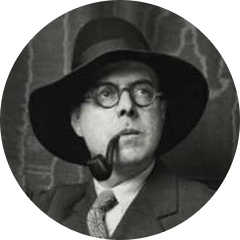Wyndham Lewis
(1882–1957)
Wyndham Lewis (1882–1957), painter, novelist, philosopher, critic, was one of the major modernist writers. A friend of Ezra Pound, Lewis was the leading artist associated with Vorticism, and editor of BLAST, the movement’s journal (1914–15), in which TSE’s ‘Preludes’ and ‘Rhapsody on a Windy Night’ appeared (July 1915). Lewis served as a bombardier and war-artist on the Western Front, 1916–18, and wrote memorable accounts of the period in his memoir Blasting and Bombardiering (1937), including brilliant portraits of TSE, Pound and Joyce, and war-time and modernist London. TSE reviewed Lewis’s first novel Tarr (1918) in The Egoist 5: 8 (Sept. 1918), describing him as ‘the most fascinating personality of our time’, in whose work ‘we recognize the thought of the modern and the energy of the cave-man’ (106). In turn, Lewis considered Eliot ‘the most interesting man in London society’ (7 Nov. 1918). TSE, who thought Lewis’s work ‘so imaginative and visually concrete’ (letter to Philip Lane, 4 Dec. 1934), published pieces by him in the Criterion and, even though Lewis was notoriously cantankerous, kept up a life-time’s friendship with him. TSE wrote to Robert Giroux, 7 Jan. 1957: ‘I am delighted to hear that you are publishing these two books. I predict a bigger sale for Monstre Gai than for Malign Fiesta – in my opinion it is much the better of the two, but you ought to do The Childermass if you have not done it. It has magnificent things in it.’ Lewis did a number of drawings of TSE, one of which hung in his flat – reproduced in vol. 2 of Letters of T. S. Eliot – and his best-known portrait of him (rejected by the Royal Academy) is now in Durban.
On Lewis’s death, TSE wrote ‘The Importance of Wyndham Lewis’ in the Sunday Times (10 Mar. 1957), and a memoir in Hudson Review X: 2 (Summer 1957): ‘He was … a highly strung, nervous man, who was conscious of his own abilities, and sensitive to slight or neglect … He was independent, outspoken, and difficult. Temperament and circumstances combined to make him a great satirist … I remember Lewis, at the time when I first knew him, and for some years thereafter, as incomparably witty and amusing in company.’ TSE wrote too, for the magazine Spectrum:
‘Wyndham Lewis was in my opinion one of the few men of letters of my generation whom I should call, without qualification, men of genius. It is for other painters and draughtsmen to praise his genius as a painter and draughtsman. I would only like to repeat what I have said several times before, that Lewis was the most prominent and versatile prose-writer of my time. I would also like to pay a special tribute to the work he did after he became blind. In Self-Condemned he seems to have written a novel greater than Tarr or The Revenge for Love; in Monstre Gai a sequel to The Childermass more remarkable than The Childermass itself. It is a great artist and one of the most intelligent men of my age who is dead’ (letter to Hugh Kenner, 27 Mar 1957).
See The Letters of Wyndham Lewis, ed. W. K. Rose (1963); Paul O’Keeffe, Some Sort of Genius: A Life of Wyndham Lewis (2000).
